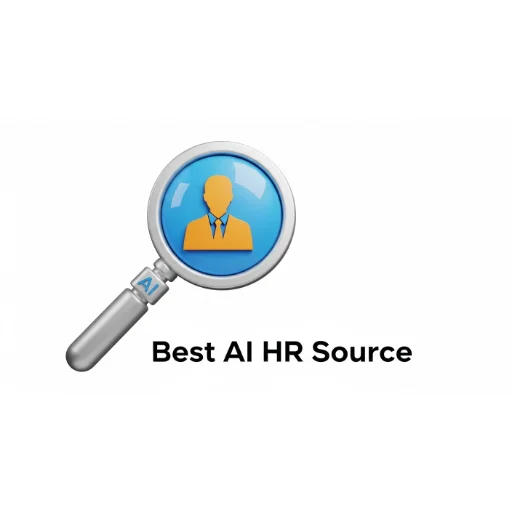Glossary of AI HR & Recruiting Terms
Welcome to the Best AI HR Source glossary. The world of Human Resources and Artificial Intelligence is filled with specialized terms and acronyms. This page serves as a living dictionary to help demystify the language of modern HR technology, ensuring you can navigate your digital transformation journey with clarity and confidence.
If you have any questions, you can always Contact Us.
A
Affiliate Marketing A business model where we may earn a commission if you purchase a product through a link on our site, at no extra cost to you. This reader-supported model funds our independent research.
Agentic AI A type of AI designed to act autonomously on a user’s behalf to achieve a specific goal. In HR, this could be an AI agent that independently schedules complex interview loops based on a set of rules and calendar availability.
Applicant Tracking System (ATS) Software that automates and manages the entire recruiting process, from posting a job to receiving applications and tracking candidates through the hiring pipeline. Modern ATS platforms are a core component of AI for Talent Acquisition.
B
Bias Reduction The use of technology and structured processes to minimize the effects of conscious or unconscious human bias in decisions, particularly in hiring and performance management. Our testing framework places a strong emphasis on evaluating the bias mitigation features of AI tools.
C
Career Pathing The process of visualizing potential career progressions for an employee within an organization. AI tools can analyze an employee’s skills and performance to recommend future roles and the developmental steps needed to achieve them.
Contingent Workforce A company’s non-permanent workers, including freelancers, independent contractors, consultants, and temporary staff. Many modern HR tools help manage the sourcing and payment of this flexible workforce.
Continuous Feedback A performance management approach where feedback is given to employees on an ongoing basis, rather than only during annual reviews. This is a key feature of modern AI for Talent Management platforms.
Core HR The foundational administrative functions of HR, including employee data management, payroll, and benefits administration. Automating these functions is the focus of Core HR & HRIS Automation.
D
Digital HR The overall strategy of using digital technology, including social media, mobile applications, and AI, to transform HR processes and improve the employee experience.
Diversity Sourcing The proactive practice of finding and engaging candidates from underrepresented groups to build a more diverse and inclusive workforce.
E
Employee Engagement The level of an employee’s emotional commitment and dedication to an organization and its goals. It is a key metric measured and improved by AI for Employee Engagement & Experience tools.
Employee Lifecycle The entire journey an employee takes with an organization, from their initial application (Talent Acquisition) to their eventual departure (offboarding). Our content is structured to follow this lifecycle.
G
Generative AI A class of artificial intelligence models that can create new, original content, such as text, images, or code, based on the data they were trained on. In HR, it’s used for writing job descriptions, creating personalized communications, and more.
H
HRIS (Human Resources Information System) A central software system used to maintain and manage all employee data, such as personal information, roles, compensation, and benefits. It is the “single source of truth” for a company’s people data.
L
LLM (Large Language Model) A type of AI that has been trained on vast amounts of text data to understand and generate human-like language. LLMs are the technology behind many generative AI tools.
N
Natural Language Processing (NLP) A field of artificial intelligence that gives computers the ability to read, understand, and interpret human language. In HR, NLP is used to analyze resumes, survey comments, and performance reviews.
O
Onboarding The process of integrating a new employee into an organization. This includes providing them with the tools, information, and connections they need to become productive members of the team.
P
Payroll The process of paying a company’s employees, including calculating wages, withholding taxes, and managing deductions. It is a critical function of Core HR systems.
People Analytics The practice of collecting and analyzing HR data to gain insights into the workforce and improve business performance. It is the focus of our HR Analytics & Workforce Planning category.
Predictive Analytics The use of data, statistical algorithms, and machine learning techniques to identify the likelihood of future outcomes based on historical data. In HR, it’s used to predict outcomes like employee turnover or hiring success.
Q
Quality of Hire A metric used to measure the value a new employee brings to an organization. It is often determined by factors like job performance, productivity, and cultural fit.
S
Sentiment Analysis The use of NLP to identify and extract subjective information from text, determining whether the writer’s attitude towards a particular topic is positive, negative, or neutral. It’s often used to analyze employee feedback surveys.
Skill Gap Analysis The process of identifying the difference between the skills an organization needs to achieve its goals and the skills its current workforce possesses.
T
Talent Acquisition The ongoing strategic process of finding, attracting, and hiring new employees to meet a company’s business objectives.
Talent Management The strategic management of an organization’s talent, including performance management, learning and development, succession planning, and employee retention.
Time-to-Hire A key recruiting metric that measures the number of days between when a job is first opened and when a candidate accepts the offer.
W
Workforce Planning The process of analyzing an organization’s current workforce and forecasting its future needs to ensure the right people with the right skills are in the right jobs at the right time.
